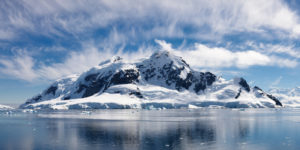Welcome to the “Ice.”
“Ice” is the international nickname for Antarctica, an alien world containing 90 percent of the planet’s ice. Ninety-eight percent of the continent is ice, yet it boasts the world’s largest desert.
It is one and one-half times the size of the United States—one of twenty countries with research stations there. The United States has three stations in Antarctica: McMurdo Station on the southern tip of Ross Island, Amundsen-Scott Station at the South Pole, and Palmer Station on Anvers Island in the Antarctic Peninsula region.
Antarctica was first spotted by explorers in the 19th century. A Russian expedition commanded by Fabian von Bellingshausen spied it January 27, 1820. Three days later, British naval officer Edward Bransfield saw the tip of the Antarctic Peninsula.
It was not until 1821, however, that explorer John Davis became the first man to set foot on the continent. The discovery of a new continent set off the Heroic Age, a 25-year period of polar exploration from 1897 to 1922.
The Expeditions of the Heroic Age
1897–1899 Belgian Antarctic Expedition, led by Adrien de Gerlache
1898–1900 Southern Cross Expedition, led by Carsten Borchgrevink for the UK
1901–1904 Discovery Expedition, led by Robert Falcon Scott for the UK
1901–1903 Gauss – German National Antarctic Expedition, led by Erich von Drygalski
1901–1904 Swedish Antarctic Expedition, led by Otto Nordenskjöld
1902–1904 Scottish National Antarctic Expedition, led by William Spiers Bruce
1903–1905 Third French Antarctic Expedition, led by Jean-Baptiste Charcot
1907–1909 Nimrod Expedition, led by Ernest Shackleton for the UK
1908–1910 Fourth French Antarctic Expedition, led by Jean-Baptiste Charcot
1910–1912 Japanese Antarctic Expedition, led by Nobu Shirase
1910–1912 Norwegian South Pole Expedition, led by Roald Amundsen
1910–1913 British Terra Nova Expedition, led by Robert Falcon Scott
1911–1913 Second German Antarctic Expedition, led by Wilhelm Filchner
1911–1914 Australasian Antarctic Expedition, led by Douglas Mawson
1914–1916 Endurance Expedition, led by Ernest Shackleton for the UK
1921–1922 Shackleton-Rowett Expedition, led by Ernest Shackleton for the UK
“Wild Ice.”
There’s no getting around it. The Frozen Continent is brutal. The land, for all its beauty, is inhabitable without the benefits of science and technology. It’s barely habitable with them.
Survival takes careful planning and knowledge of basic skills you don’t have to worry about on most continents. Notwithstanding a tourist cruise to Antarctica, most people can’t just pack up a suitcase and skip down to Antarctica for a little adventure. Applicants must be approved and pass a physical examination. The trip involves meticulous planning.
It’s crucial to take along the ability to adapt to hardship and the willingness to follow rules.
It helps to have a sense of humor, too. In the rough-and-tumble world of environmental challenges, close quarters, and maddening boredom, station mainstays and part-timers alike develop their own adaptation techniques. A wild-west mentality not unlike what followed in the wake of other pioneers dots the social landscape.
The slang developed by Antarctic adventurers has spawned a dictionary of its own for English speakers, The Antarctic Dictionary: The Complete Guide to Antarctic English, to help new arrivals navigate the wild ice.
Here’s a few terms gathered by John Kelly for Mental Floss:
City Mice, Country Mice, and Beakers
MacTown is the Antarctician term for McMurdo Station.
City Mice are the personnel who work at the stations.
Country Mice work in the field.
Fingee or Fingy is a derogatory name for a newbie to the Ice.
Beaker is a scientist.
Snotcicle is exactly what it sounds like.
Who owns Antarctica?
Antarctica doesn’t belong to anyone. For years, though, nations have jockeyed for a piece of it. There are seven countries with territorial claims: Argentina, Australia, Chile, France, New Zealand, Norway, and the United Kingdom. Though a U.S. entity, McMurdo Station sits on territory claimed as a dependency of New Zealand.
Twelve countries originally signed the Antarctic Treaty in 1959: Argentina, Australia, Belgium, Chile, France, Japan, New Zealand, Norway, South Africa, the Soviet Union, the United Kingdom, and the United States of America. The flags of these countries are displayed at McMurdo Station’s Chalet and at the South Pole.
Today there are fifty-four nations in the Antarctic Treaty.
Coming next week: The Dark Side of the Ice
https://www.mentalfloss.com/article/85378/23-slang-terms-you-only-understand-if-you-work-antarctica
Photo 12163709 © Patrick Poendl | Dreamstime.com


























Leave a Reply